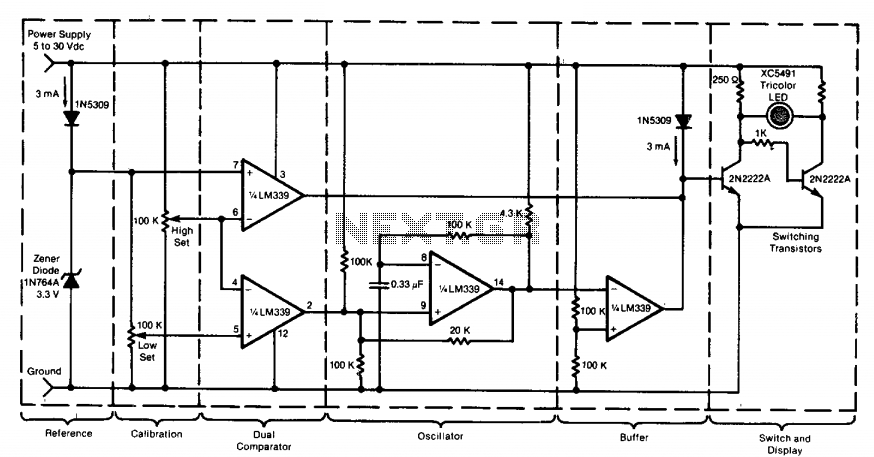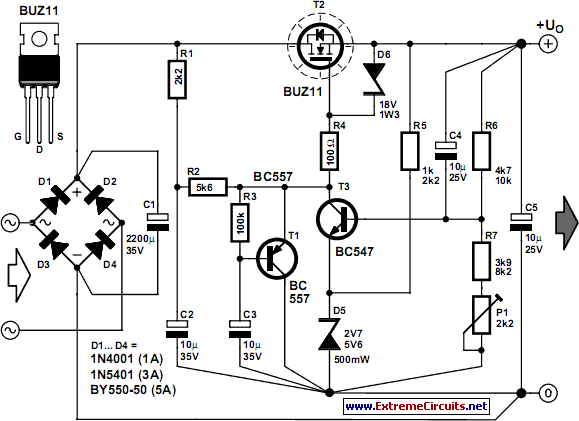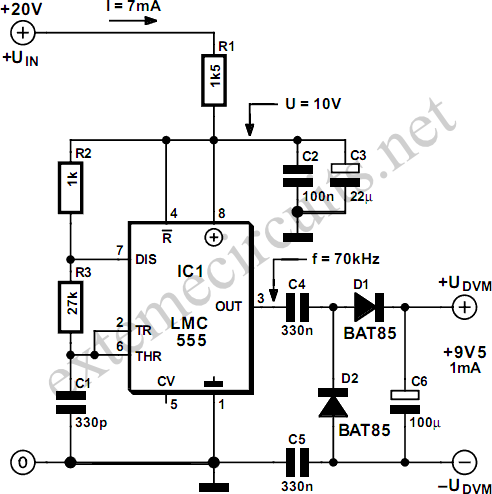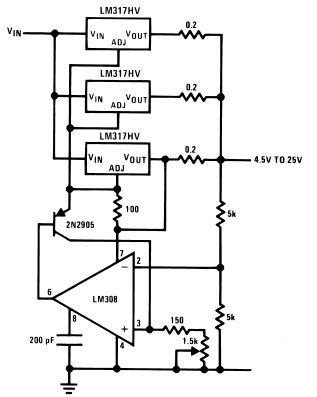
0-15V 1A Variable power supply
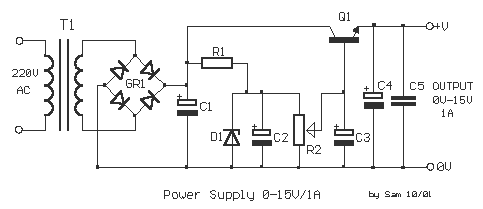
This circuit of power supply, are very simple in the manufacture, the finding of his materials, is very easy and cost, small. The output voltage is stabilised and is regulated in the region from 0V until + 15V dc, with biggest provided current 1 A. The regulation becomes with the R2. The Q1 of is classic power transistor and it needs it is placed in heatsink, one and heating when it works continuously in the region of biggest current. The type of transformer is standard in the market. More: R1= 56ohm 2W Q1= 2N3055 R2= 330ohm Lin. pot. T1=220V@18V 1.5A C1= 2200uF 35V C2= 100uF 35V D1= 18V 1.5W zener C3= 10uF 25V C4= 220uF 25V C5= 100nF 100V GR1= 4 X 1N4007
This power supply circuit is designed to provide a stabilized output voltage ranging from 0V to +15V DC, with a maximum output current of 1A. The primary components include a transformer, a linear voltage regulator, capacitors for filtering, and a power transistor for current amplification.
The transformer (T1) is a standard 220V AC to 18V AC transformer rated at 1.5A. This transformer steps down the mains voltage to a lower AC voltage suitable for rectification. The output from the transformer is then rectified using a bridge rectifier configuration, which consists of four 1N4007 diodes (GR1). This configuration converts the AC voltage to pulsating DC voltage.
The pulsating DC output is smoothed using a large electrolytic capacitor (C1, 2200uF, 35V), which reduces the ripple voltage and provides a more stable DC voltage. Additional capacitors (C2, C3, C4, and C5) are included in the circuit to further filter the output and stabilize the voltage. C2 (100uF, 35V) is used for additional smoothing, while C3 (10uF, 25V) and C4 (220uF, 25V) help with transient response and stability. C5 (100nF, 100V) serves as a high-frequency bypass capacitor to filter out high-frequency noise.
The output voltage is regulated using a linear potentiometer (R2, 330 ohm), allowing for adjustable voltage output. The power transistor (Q1, 2N3055) is a classic choice for linear regulation, capable of handling significant current loads. It is crucial to mount the transistor on a heatsink to dissipate heat generated during operation, especially when delivering maximum current.
R1 (56 ohm, 2W) is used as a current limiting resistor to protect the circuit during startup and provide stability. A zener diode (D1, 18V, 1.5W) is incorporated to provide over-voltage protection and ensure that the output voltage does not exceed the desired level.
This circuit is suitable for various applications requiring a reliable and adjustable power supply, making it an excellent choice for hobbyists and professionals alike. The simplicity of the design, combined with the availability of components, contributes to its effectiveness and cost efficiency.This circuit of power supply, are very simple in the manufacture, the finding of his materials , is very easy and cost, small. The output voltage is stabilised and is regulated in the region from 0V until + 15V dc, with biggest provided current 1 A.
The regulation becomes with the R2. The Q1 of is classic power transistor and it needs it is placed in heatsink, one and heating when it works continuously in the region of biggest current. The type of transformer is standard in the market. R1= 56ohm 2W Q1= 2N3055 R2= 330ohm Lin. pot. T1=220V@18V 1.5A C1= 2200uF 35V C2= 100uF 35V D1= 18V 1.5W zener C3= 10uF 25V C4= 220uF 25V C5= 100nF 100V GR1= 4 X 1N4007 🔗 External reference
This power supply circuit is designed to provide a stabilized output voltage ranging from 0V to +15V DC, with a maximum output current of 1A. The primary components include a transformer, a linear voltage regulator, capacitors for filtering, and a power transistor for current amplification.
The transformer (T1) is a standard 220V AC to 18V AC transformer rated at 1.5A. This transformer steps down the mains voltage to a lower AC voltage suitable for rectification. The output from the transformer is then rectified using a bridge rectifier configuration, which consists of four 1N4007 diodes (GR1). This configuration converts the AC voltage to pulsating DC voltage.
The pulsating DC output is smoothed using a large electrolytic capacitor (C1, 2200uF, 35V), which reduces the ripple voltage and provides a more stable DC voltage. Additional capacitors (C2, C3, C4, and C5) are included in the circuit to further filter the output and stabilize the voltage. C2 (100uF, 35V) is used for additional smoothing, while C3 (10uF, 25V) and C4 (220uF, 25V) help with transient response and stability. C5 (100nF, 100V) serves as a high-frequency bypass capacitor to filter out high-frequency noise.
The output voltage is regulated using a linear potentiometer (R2, 330 ohm), allowing for adjustable voltage output. The power transistor (Q1, 2N3055) is a classic choice for linear regulation, capable of handling significant current loads. It is crucial to mount the transistor on a heatsink to dissipate heat generated during operation, especially when delivering maximum current.
R1 (56 ohm, 2W) is used as a current limiting resistor to protect the circuit during startup and provide stability. A zener diode (D1, 18V, 1.5W) is incorporated to provide over-voltage protection and ensure that the output voltage does not exceed the desired level.
This circuit is suitable for various applications requiring a reliable and adjustable power supply, making it an excellent choice for hobbyists and professionals alike. The simplicity of the design, combined with the availability of components, contributes to its effectiveness and cost efficiency.This circuit of power supply, are very simple in the manufacture, the finding of his materials , is very easy and cost, small. The output voltage is stabilised and is regulated in the region from 0V until + 15V dc, with biggest provided current 1 A.
The regulation becomes with the R2. The Q1 of is classic power transistor and it needs it is placed in heatsink, one and heating when it works continuously in the region of biggest current. The type of transformer is standard in the market. R1= 56ohm 2W Q1= 2N3055 R2= 330ohm Lin. pot. T1=220V@18V 1.5A C1= 2200uF 35V C2= 100uF 35V D1= 18V 1.5W zener C3= 10uF 25V C4= 220uF 25V C5= 100nF 100V GR1= 4 X 1N4007 🔗 External reference
